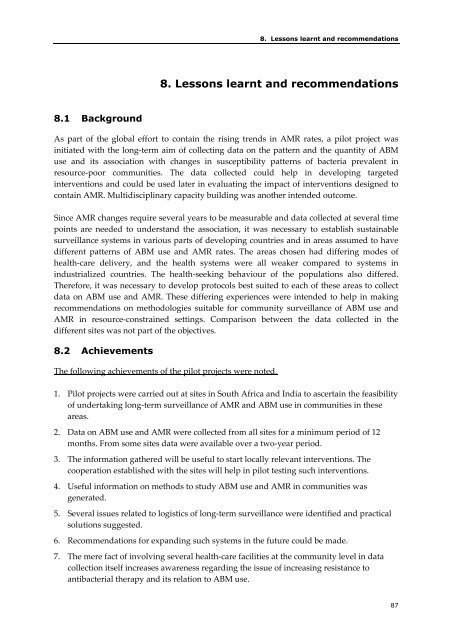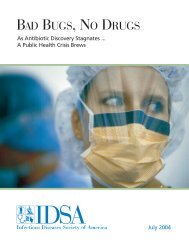Community-Based Surveillance of Antimicrobial Use and ...
Community-Based Surveillance of Antimicrobial Use and ...
Community-Based Surveillance of Antimicrobial Use and ...
- No tags were found...
Create successful ePaper yourself
Turn your PDF publications into a flip-book with our unique Google optimized e-Paper software.
8. Lessons learnt <strong>and</strong> recommendations8. Lessons learnt <strong>and</strong> recommendations8.1 BackgroundAs part <strong>of</strong> the global effort to contain the rising trends in AMR rates, a pilot project wasinitiated with the long‐term aim <strong>of</strong> collecting data on the pattern <strong>and</strong> the quantity <strong>of</strong> ABMuse <strong>and</strong> its association with changes in susceptibility patterns <strong>of</strong> bacteria prevalent inresource‐poor communities. The data collected could help in developing targetedinterventions <strong>and</strong> could be used later in evaluating the impact <strong>of</strong> interventions designed tocontain AMR. Multidisciplinary capacity building was another intended outcome.Since AMR changes require several years to be measurable <strong>and</strong> data collected at several timepoints are needed to underst<strong>and</strong> the association, it was necessary to establish sustainablesurveillance systems in various parts <strong>of</strong> developing countries <strong>and</strong> in areas assumed to havedifferent patterns <strong>of</strong> ABM use <strong>and</strong> AMR rates. The areas chosen had differing modes <strong>of</strong>health‐care delivery, <strong>and</strong> the health systems were all weaker compared to systems inindustrialized countries. The health‐seeking behaviour <strong>of</strong> the populations also differed.Therefore, it was necessary to develop protocols best suited to each <strong>of</strong> these areas to collectdata on ABM use <strong>and</strong> AMR. These differing experiences were intended to help in makingrecommendations on methodologies suitable for community surveillance <strong>of</strong> ABM use <strong>and</strong>AMR in resource‐constrained settings. Comparison between the data collected in thedifferent sites was not part <strong>of</strong> the objectives.8.2 AchievementsThe following achievements <strong>of</strong> the pilot projects were noted.1. Pilot projects were carried out at sites in South Africa <strong>and</strong> India to ascertain the feasibility<strong>of</strong> undertaking long‐term surveillance <strong>of</strong> AMR <strong>and</strong> ABM use in communities in theseareas.2. Data on ABM use <strong>and</strong> AMR were collected from all sites for a minimum period <strong>of</strong> 12months. From some sites data were available over a two‐year period.3. The information gathered will be useful to start locally relevant interventions. Thecooperation established with the sites will help in pilot testing such interventions.4. <strong>Use</strong>ful information on methods to study ABM use <strong>and</strong> AMR in communities wasgenerated.5. Several issues related to logistics <strong>of</strong> long‐term surveillance were identified <strong>and</strong> practicalsolutions suggested.6. Recommendations for exp<strong>and</strong>ing such systems in the future could be made.7. The mere fact <strong>of</strong> involving several health‐care facilities at the community level in datacollection itself increases awareness regarding the issue <strong>of</strong> increasing resistance toantibacterial therapy <strong>and</strong> its relation to ABM use.87




